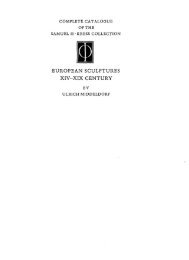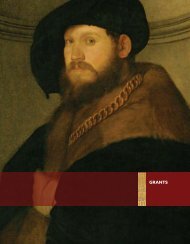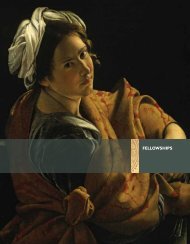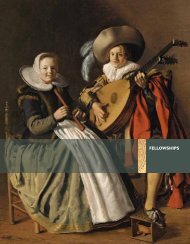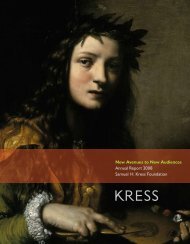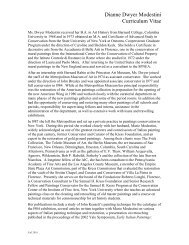The Campus Art Museum - Samuel H. Kress Foundation
The Campus Art Museum - Samuel H. Kress Foundation
The Campus Art Museum - Samuel H. Kress Foundation
You also want an ePaper? Increase the reach of your titles
YUMPU automatically turns print PDFs into web optimized ePapers that Google loves.
that it is particularly prevalent. In describing the Spencer’s efforts to reach out and<br />
connect, respondents used images of a portal, the sun or a star. A museum intern<br />
likened the Spencer to “one star within a constellation... all the things we have<br />
going on here, sort of like this nuclear fission of ideas just sort of bubbling away,<br />
but also we have these connections to other places within the broader community<br />
and also within the campus.” <strong>The</strong> images of the Spencer as a portal and place of<br />
“bubbling ideas” fit well with what I heard and saw there. As a portal, the museum<br />
is a gateway and a link among people, resources, and ideas.<br />
Several other metaphors include the campus art museum as a nursery,<br />
important in nourishing future artists, art historians, and curators. Interviews with<br />
students and museum staff provide evidence that a good art museum can help,<br />
indeed, to create artists, art historians, museum directors, curators, art educators, as<br />
well as an educated and interested public. A few describe the campus art museum<br />
as the heart or center of the college or university, particularly at Indiana University<br />
(IU) where that was also physically true. Situated in the middle of the campus,<br />
thousands of students go by the museum everyday from their dorms to classes on a<br />
path known as the “long march.” In addition to being physically at the center of the<br />
campus, the Indiana University <strong>Art</strong> <strong>Museum</strong> (IUAM) was, in 2010, also enjoying<br />
being at the center of attention as part of a Year of the <strong>Museum</strong> initiative out of the<br />
provost’s office.<br />
If given a list of these metaphors and asked to choose which fit their museum,<br />
interviewees probably would say that their campus art museums are, for example,<br />
both a portal and a laboratory, or a gem and a nursery. <strong>The</strong> museum plays multiple<br />
functions. <strong>The</strong> dominant metaphors in use, however, tend to reflect a group’s<br />
expectations and actions. If people see the museum as a gem and treasure, they are<br />
moved to value and protect it. But as a gem, it is somewhat set apart and positioned<br />
for a different type of interaction than, for instance, the museum as laboratory.<br />
Viewing the museum as a lab, people are more apt to think about interactions with<br />
collections or visitors. Seeing the museum as a library, faculty and students across<br />
disciplines seek out ways to make use of its resources. Thinking of the museum<br />
as a portal or gateway extends even further the scope and reach of the museum.<br />
Metaphors help shape actions. Together, the metaphors that interviewees use<br />
suggest perspectives on what campus art museum are and could be.<br />
Supportive <strong>Campus</strong> Cultures and<br />
Structures<br />
Like metaphors, the cultures in which we are embedded affect how we think<br />
and what we do. Two possibly interrelated campus cultures assist in creating a<br />
climate for institutional support of campus art museums. One is a history and<br />
culture on campus of supporting the arts and the other is an institutional culture<br />
of collaborative and interdisciplinary learning. Organizational structures and<br />
procedures can also unwittingly affect campus art museums. Two identified<br />
through this research include the positioning of the museum within the overall<br />
campus structure and the ways in which general funds are allocated.<br />
Supportive <strong>Campus</strong> Cultures and Structures<br />
7



